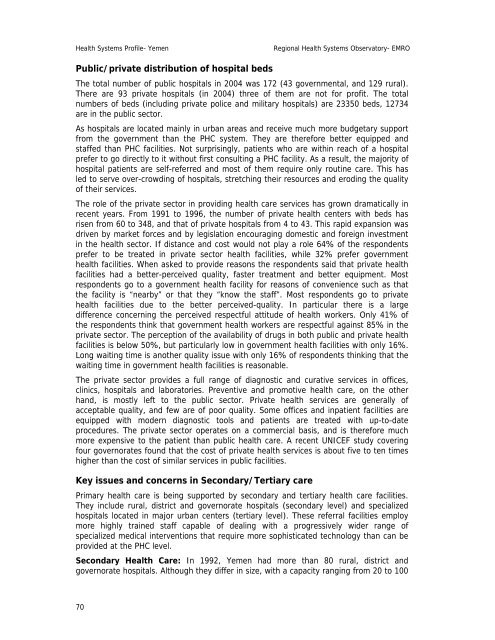Yemen - What is GIS - World Health Organization
Yemen - What is GIS - World Health Organization
Yemen - What is GIS - World Health Organization
Create successful ePaper yourself
Turn your PDF publications into a flip-book with our unique Google optimized e-Paper software.
<strong>Health</strong> Systems Profile- <strong>Yemen</strong> Regional <strong>Health</strong> Systems Observatory- EMRO<br />
Public/private d<strong>is</strong>tribution of hospital beds<br />
The total number of public hospitals in 2004 was 172 (43 governmental, and 129 rural).<br />
There are 93 private hospitals (in 2004) three of them are not for profit. The total<br />
numbers of beds (including private police and military hospitals) are 23350 beds, 12734<br />
are in the public sector.<br />
As hospitals are located mainly in urban areas and receive much more budgetary support<br />
from the government than the PHC system. They are therefore better equipped and<br />
staffed than PHC facilities. Not surpr<strong>is</strong>ingly, patients who are within reach of a hospital<br />
prefer to go directly to it without first consulting a PHC facility. As a result, the majority of<br />
hospital patients are self-referred and most of them require only routine care. Th<strong>is</strong> has<br />
led to serve over-crowding of hospitals, stretching their resources and eroding the quality<br />
of their services.<br />
The role of the private sector in providing health care services has grown dramatically in<br />
recent years. From 1991 to 1996, the number of private health centers with beds has<br />
r<strong>is</strong>en from 60 to 348, and that of private hospitals from 4 to 43. Th<strong>is</strong> rapid expansion was<br />
driven by market forces and by leg<strong>is</strong>lation encouraging domestic and foreign investment<br />
in the health sector. If d<strong>is</strong>tance and cost would not play a role 64% of the respondents<br />
prefer to be treated in private sector health facilities, while 32% prefer government<br />
health facilities. When asked to provide reasons the respondents said that private health<br />
facilities had a better-perceived quality, faster treatment and better equipment. Most<br />
respondents go to a government health facility for reasons of convenience such as that<br />
the facility <strong>is</strong> “nearby” or that they “know the staff”. Most respondents go to private<br />
health facilities due to the better perceived-quality. In particular there <strong>is</strong> a large<br />
difference concerning the perceived respectful attitude of health workers. Only 41% of<br />
the respondents think that government health workers are respectful against 85% in the<br />
private sector. The perception of the availability of drugs in both public and private health<br />
facilities <strong>is</strong> below 50%, but particularly low in government health facilities with only 16%.<br />
Long waiting time <strong>is</strong> another quality <strong>is</strong>sue with only 16% of respondents thinking that the<br />
waiting time in government health facilities <strong>is</strong> reasonable.<br />
The private sector provides a full range of diagnostic and curative services in offices,<br />
clinics, hospitals and laboratories. Preventive and promotive health care, on the other<br />
hand, <strong>is</strong> mostly left to the public sector. Private health services are generally of<br />
acceptable quality, and few are of poor quality. Some offices and inpatient facilities are<br />
equipped with modern diagnostic tools and patients are treated with up-to-date<br />
procedures. The private sector operates on a commercial bas<strong>is</strong>, and <strong>is</strong> therefore much<br />
more expensive to the patient than public health care. A recent UNICEF study covering<br />
four governorates found that the cost of private health services <strong>is</strong> about five to ten times<br />
higher than the cost of similar services in public facilities.<br />
Key <strong>is</strong>sues and concerns in Secondary/Tertiary care<br />
Primary health care <strong>is</strong> being supported by secondary and tertiary health care facilities.<br />
They include rural, d<strong>is</strong>trict and governorate hospitals (secondary level) and specialized<br />
hospitals located in major urban centers (tertiary level). These referral facilities employ<br />
more highly trained staff capable of dealing with a progressively wider range of<br />
specialized medical interventions that require more soph<strong>is</strong>ticated technology than can be<br />
provided at the PHC level.<br />
Secondary <strong>Health</strong> Care: In 1992, <strong>Yemen</strong> had more than 80 rural, d<strong>is</strong>trict and<br />
governorate hospitals. Although they differ in size, with a capacity ranging from 20 to 100<br />
70

















